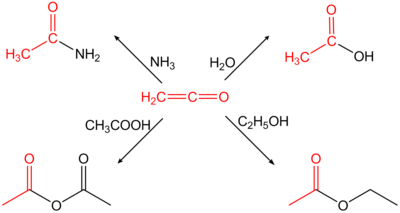Ethenone

| |

| |
| Names | |
|---|---|
| Preferred IUPAC name
Ethenone[1] | |
| Other names
Ketene
Carbomethene Keto-ethylene | |
| Identifiers | |
3D model (
JSmol ) |
|
| 1098282 | |
| ChEBI | |
| ChemSpider | |
ECHA InfoCard
|
100.006.671 |
| EC Number |
|
PubChem CID
|
|
RTECS number
|
|
| UNII | |
CompTox Dashboard (EPA)
|
|
| |
| |
| Properties | |
| C2H2O | |
| Molar mass | 42.037 g/mol |
| Appearance | Colourless gas |
| Odor | penetrating |
| Density | 1.93 g/cm3 |
| Melting point | −150.5 °C (−238.9 °F; 122.6 K) |
| Boiling point | −56.1 °C (−69.0 °F; 217.1 K) |
| decomposes | |
| Solubility | soluble in |
| Vapor pressure | >1 atm (20°C)[2] |
Refractive index (nD)
|
1.4355 |
| Thermochemistry | |
Heat capacity (C)
|
51.75 J/K mol |
Std enthalpy of (ΔfH⦵298)formation |
-87.24 kJ/mol |
| Hazards | |
| NFPA 704 (fire diamond) | |
| Flash point | −107 °C (−161 °F; 166 K) |
Explosive limits
|
5.5-18% |
| Lethal dose or concentration (LD, LC): | |
LD50 (median dose)
|
1300 mg/kg (oral, rat) |
LC50 (median concentration)
|
17 ppm (mouse, 10 min)[3] |
LCLo (lowest published)
|
23 ppm (mouse, 30 min) 53 ppm (rabbit, 2 hr) 53 ppm (guinea pig, 2 hr) 750 ppm (cat, 10 min) 200 ppm (monkey, 10 min) 50 ppm (mouse, 10 min) 1000 ppm (rabbit, 10 min)[3] |
| NIOSH (US health exposure limits): | |
PEL (Permissible)
|
TWA 0.5 ppm (0.9 mg/m3)[2] |
REL (Recommended)
|
TWA 0.5 ppm (0.9 mg/m3) ST 1.5 ppm (3 mg/m3)[2] |
IDLH (Immediate danger) |
5 ppm[2] |
| Safety data sheet (SDS) | External MSDS |
Except where otherwise noted, data are given for materials in their standard state (at 25 °C [77 °F], 100 kPa).
| |
In organic chemistry, ethenone is the formal name for ketene, an organic compound with formula C2H2O or H2C=C=O. It is the simplest member of the ketene class. It is an important reagent for acetylations.[4]
Properties
Ethenone is a highly reactive gas (at
Preparation
Ethenone is produced by thermal dehydration of acetic acid at 700–750 °C in the presence of triethyl phosphate as a catalyst:[6][7]
- CH3CO2H → CH2=C=O + H2O
It has also been produced on a laboratory scale by the thermolysis of acetone at 600–700 °C.[8][9]
- CH3COCH3 →CH2=C=O + CH4
This reaction is called the Schmidlin ketene synthesis.[10]
On a laboratory scale it can be produced by the thermal decomposition of Meldrum's acid at temperatures greater than 200 °C.[citation needed]
History
When passed through heated pipes or electrically heated metal (like copper) wires at 500-600 °C in the presence of carbon disulfide, acetone decomposes into methane and ethenone, with 95% yield.[11][12] Ethenone was discovered at the same time by Hermann Staudinger (by reaction of bromoacetyl bromide with metallic zinc)[13][14] The dehydration of acetic acid was reported in 1910.[15]

The thermal decomposition of acetic anhydride was also described.[16]



Natural occurrence
Ethenone has been observed to occur in space, in comets or in gas as part of the interstellar medium.[17]
Use
Ethenone is used to make acetic anhydride from acetic acid. Generally it is used for the acetylation of chemical compounds.[18]
Ethenone reacts with
Ethenone is very reactive, tending to react with
The formation of acetic acid likely occurs by an initial formation of
Ethenone will also react with itself via
Hazards
Exposure to concentrated levels causes humans to experience irritation of body parts such as the
The formation of ketene in the
Occupational exposure limits are set at 0.5 ppm (0.9 mg/m3) over an eight-hour time-weighted average.[31] An
References
- ISBN 978-0-85404-182-4.
- ^ a b c d NIOSH Pocket Guide to Chemical Hazards. "#0367". National Institute for Occupational Safety and Health (NIOSH).
- ^ a b "Ketene". Immediately Dangerous to Life or Health Concentrations (IDLH). National Institute for Occupational Safety and Health (NIOSH).
- ISBN 978-3527306732.
- ^ EP 0377438, R. Bergamin et al., issued 1990-06-11, assigned to Lonza AG
- ISBN 978-3-527-30385-4.
- ]
- ISBN 978-0471937494.
- ^ Hurd CD, Kamm O (1941). "Ketene in Organic Syntheses". Organic Syntheses. Vol. Collective Vol. 1. p. 330.
- .
- ISBN 978-3-8171-1761-1.
- .
- .
- S2CID 37437108.
- ^ a b Entry on Diketen. at: Römpp Online. Georg Thieme Verlag, retrieved 16. Juni 2014.
- ISBN 978-3-527-31540-6.
- ^ EP 1295860, D. Decker et al., issued 26. März 2003-03-26, assigned to Nutrinova GmbH
- ^ Tidwell, p. 11.
- ^ Tidwell, p. 560.
- ^ ChemSpider http://www.chemspider.com/Chemical-Structure.9643.html
- doi:10.1139/v99-090.
- ^ Christoph Taeschler :Ketenes, Ketene Dimers, and Related Substances, Kirk-Othmer Encyclopedia of Chemical Technology, John Wiley & Sons, New York, 2010
- .
- ^ "The Vaping-Related Lung Disease Outbreak May be Coming to an End". 20 December 2019.
- PMID 32156732.
- S2CID 219919028.
- ^ U.S. patent No. 5475144. Catalyst and process for synthesis of ketenes from carboxylic acids. Dec 12, 1995. https://patents.google.com/patent/US5475144A/en
- ^ Centers for Disease Control and Prevention (4 April 2013). "Ketene". NIOSH Pocket Guide to Chemical Hazards. Retrieved 13 November 2013.
- ^ Centers for Disease Control and Prevention (May 1994). "Ketene". Documentation for Immediately Dangerous To Life or Health Concentrations (IDLHs). Retrieved 13 November 2013.
Literature
- Tidwell, Thomas T. Ketenes, 2nd edition. John Wiley & Sons, 2006, ISBN 978-0-471-69282-9.
External links
 Media related to Ethenone at Wikimedia Commons
Media related to Ethenone at Wikimedia Commons



